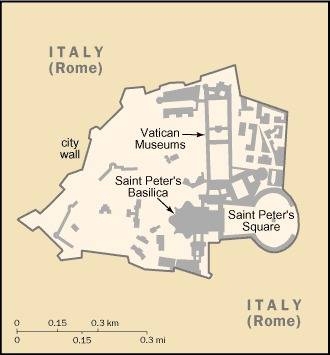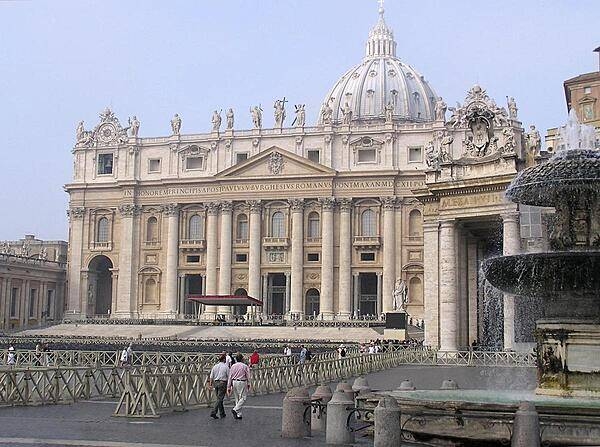81 Holy See

Two vertical bands of yellow (hoist side) and white with the arms of the Holy See, consisting of the crossed keys of Saint Peter surmounted by the three-tiered papal tiara, centered in the white band; the yellow color represents the pope’s spiritual power, the white his worldly power.
Flag courtesy of the CIA World Factbook

Map courtesy of the CIA World Factbook

The facade of St. Peter’s Basilica as viewed from next to one of the two matching Bernini fountains that grace St. Peter’s Square (Piazza) in front of the church. The attic or upper story displays statues of Christ, his apostles, and St. John the Baptist. Constructed over a period of 80 years and consecrated in 1626, the basilica is the largest Christian church in the world – capable of holding some 60,000 people.
Photo courtesy of the CIA World Factbook
Last updated on March 19, 2025
Government
According to Britannica, Holy See, the government of the Roman Catholic Church, which is led by the pope as the bishop of Rome. The word see comes from the Latin sedes, meaning “seat,” which refers to the episcopal chair occupied by a bishop and the area over which he has responsibility. As the preeminent episcopal jurisdiction of the Roman Catholic Church, the Holy See forms the church’s central government and makes decisions on issues of faith and morality for Catholics throughout the world, a population of about 1.3 billion. It resides in Vatican City, an independent state established in 1929 to allow the pope to exercise his universal authority. However, it also functions as a nonterritorial institution whose authority endures even when there is no pope, during sede vacant (“empty seat”), such as the interim between a pope’s death and the election of his successor.
The Holy See’s administration is a top-down bureaucracy run by the Roman Curia, a group of dicasteries (also known as departments), congregations, and councils with specific functions and responsibilities relating to church matters such as liturgy and worship, religious education, missionary activities, doctrine of the faith, or bishops and clergy. This administrative structure is often likened to a president and prime minister system, with the pope serving as president or head of state and the cardinal secretary of state serving as prime minister or head of government.
The cardinal secretary of state administers the Secretariat of State, which oversees both internal church operations and external diplomatic relations. These sets of oversight are divided into three sections known as General Affairs (formerly called ordinary), Relations with States (formerly called extraordinary), and Diplomatic Staff of the Holy See. These are run by Vatican officials, known as substitutes (from the Italian sostituto), who are of archbishop rank. Responsibilities of the General Affairs section include regulating the duties and activities of the Roman Curia, including enacting promotions, and supervising the Holy See’s official communications agencies and publications. The General Affairs section also keeps custody of church documents and ceremonial items such as the pope’s bulla (lead seal) and Fisherman’s Ring, which are used to sign and seal papal briefs. The Relations with States section oversees papal diplomatic services, including the Holy See’s establishment of concordats, or treaties, with other states and its representation in international organizations. Established in 2017 by Pope Francis, the Diplomatic Staff of the Holy See section deals exclusively with matters relating to the staff who work in the diplomatic service of the Holy See, such as working conditions and career advancement.
The three sections of the Secretariat of State rely on nuncios, or papal ambassadors, to carry out the Holy See’s diplomatic functions around the world. Many of these are graduates of the Pontifical Ecclesiastical Academy in Rome, the world’s oldest school of diplomacy, founded in 1701.
As an independent sovereignty, the Holy See is recognized by international law and maintains diplomatic relations with other independent states. Its enduring authority regardless of the presence of a sitting pope and beyond the physical limits of the Vatican City state is an important distinction of its special sovereignty compared with traditional world governments.
The Holy See’s membership in international organizations includes the Organization for Security and Cooperation in Europe and observer status in the World Health Organization, the Council of Europe, the Organization of American States, and the United Nations (UN). Its permanent observer status at the UN allows the Holy See to participate in General Assembly and Security Council meetings and debates, vote on procedures, and co-sponsor draft resolutions, but it may not vote on the passage of resolutions, ostensibly preserving the Holy See’s neutrality and universal moral authority.
Civil / National Aviation Authority (CAA/NAA)
US Department of State – Holy See
Airspace
SkyVector – Google Maps – ADS-B Exchange
ICAO countries publish an Aeronautical Information Publication (AIP). This document is divided into three parts: General (GEN), En Route (ENR) and Aerodromes (AD). ENR 1.4 details the types of airspace classes they chose to adopt from classes A through G.
Drone Regulations
None found by the author.
However, should you, the reader, happen to stumble across something to the contrary, please email the author at FISHE5CA@erau.edu and you may be mentioned in the ACKNOWLEDGEMENTS section of this book by way of thanks for contributing to this free eBook!
Advanced Air Mobility (AAM) Regulations & Policies
None found by the author.
However, should you, the reader, happen to stumble across something to the contrary, please email the author at FISHE5CA@erau.edu and you may be mentioned in the ACKNOWLEDGEMENTS section of this book by way of thanks for contributing to this free eBook!
Advanced Air Mobility (AAM) News
None found by the author.
However, should you, the reader, happen to stumble across something to the contrary, please email the author at FISHE5CA@erau.edu and you may be mentioned in the ACKNOWLEDGEMENTS section of this book by way of thanks for contributing to this free eBook!
Short Essay Questions
Scenario-Based Question
You have been hired by a Drone Startup Company. Your boss has immediately assigned this job to you.
They need you to prepare a one-page memo detailing the legalities of using a drone to film the Vatican, pictured above.
They need you to mention any national laws and local ordinances.
They specifically want to know what airspace (insert pictures) you will be operating in and whether or not you need an airspace authorization.
Does it matter whether or not you are a citizen of the country?
Lastly, there is a bonus for you if, as you scroll through this chapter, you find any typos or broken links!
Short Essay Questions
- What are the drone categories?
- How is registration addressed?
- How is remote ID addressed?
- What are the model aircraft rules?
- What are the commercial drone rules?
- Are there waivers or exemptions to the rules? If so, for what?
- Would you share a link to an interactive airspace map?
- How is BVLOS addressed?
- How can you fly drones at night?
- How can you fly drones over people?
- Where do you find drone NOTAMs?
- What are the rules for drone maintenance?
- What are the rules for an SMS program?
- What are some unique rules not mentioned above?
- What are the C-UAS rules?
- What are the AAM rules?

